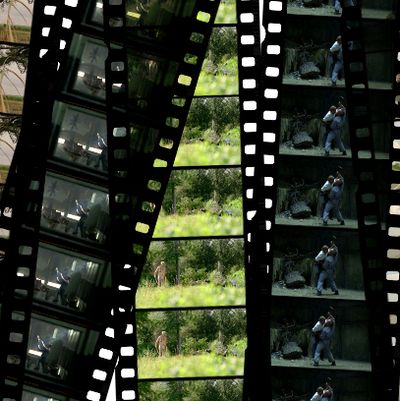
These days, most post-TV episode reactions lean toward “I can’t believe that happened!” rather than “How beautiful was that wide shot!” With True Detective, showrunner Nic Pizzolatto wanted both. So he got Sin Nombre and Jane Eyre director Cary Joji Fukunaga, and also tapped Adam Arkapaw, the Australian cinematographer behind the critically acclaimed crime dramas Animal Kingdom and The Snowtown Murders. It helped that Arkapaw was coming off Jane Campion’s Top of the Lake, another transcendent small-screen experience. Shooting True Detective entirely on Kodak film (save for episode four’s momentous six-minute-long shot that required digital just to pull off the run time), Fukunaga and Arkapaw unraveled a very cinematic television saga. Behind every hair-brained Yellow King theory, there was consideration for light, color, composition, texture, and camera movement.
Just this week, Fukunaga told the Guardian, “Before I even started working on True Detective, I made a point of telling Nic … that one of my priorities as director was to defend craft despite the constraints on my time and budget. In every episode I wanted to at least try to find specific moments in which you could treat the visual side of the medium with the same importance as we were treating the dialogue.” From across the sea in England, where he’s currently shooting Michael Fassbender in the latest incarnation of Macbeth, Arkapaw revealed the thinking that helped shape True Detective into something especially striking. (Note: We didn’t talk to Arkapaw about episode four’s now-famous single-take shot because we figured it had been picked over enough by now.)
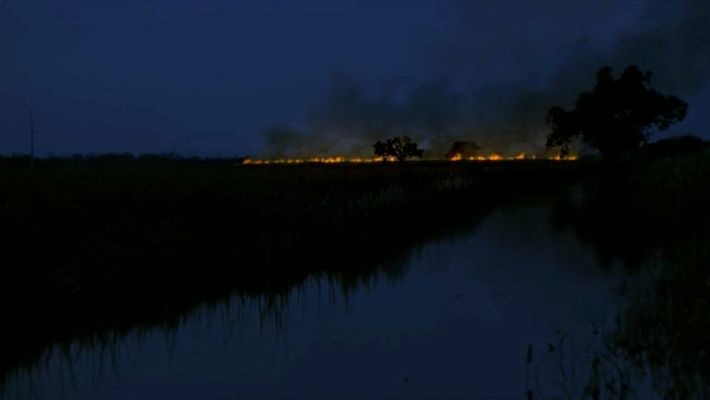
Episode one, “The Long Bright Dark” — Fire at Dusk
Season one’s mood-setting opening shot was botched. Beautifully botched, but the incalculable life span of the sequence’s raging fire had Fukunaga, Arkapaw, and the production team revising their plans on the fly. In the original concept, Errol would light the cane-field inferno against a fiery dusk sky. That was the plan when the True Detective team set actual land ablaze. With only 15 minutes before their location was supposed to smolder into ash and smoke, Arkapaw simultaneously shot from a number of angles to maximize coverage. “We had five cameras out there: two on cranes, one on a dolly, and one static really wide, and I was running around handheld,” the DP says. “I was shooting bits of the killer starting the fire. I don’t think they used any of that.”
The problem? The fire didn’t last 15 minutes; it lasted 90. And by the time it was fully raging, the sun had set and a twilight blue covered the sky. This required a bit of photographical engineering, switching film stocks to adjust for lower light and later tinkering with footage shot at the beginning. Mistake or no, the end product looks eerier than the original plan. Arkapaw says it fits their original motive: “We wanted to draw the audience in and make a statement about [the show] as a piece of cinema as opposed to a piece of television.”
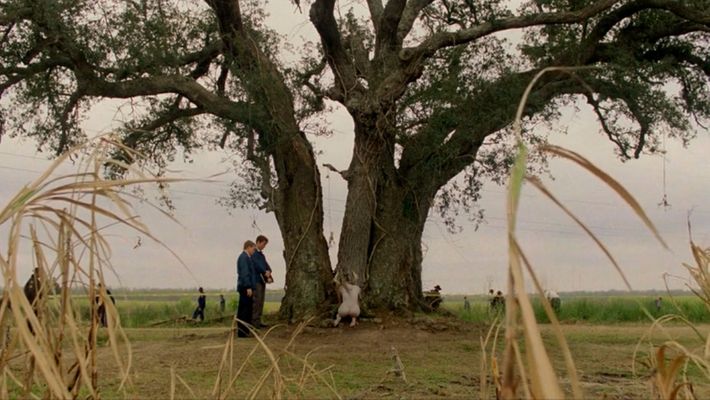
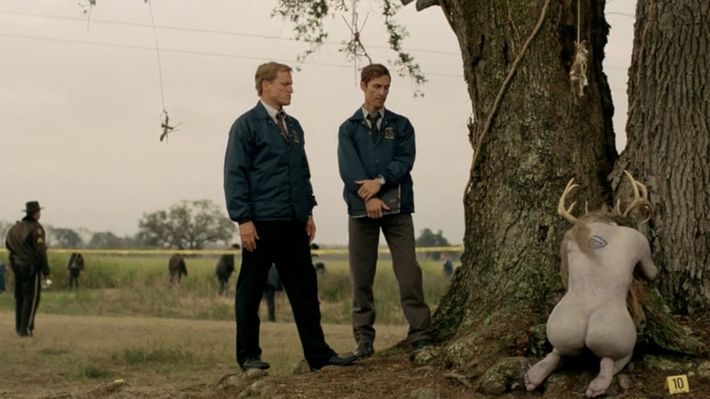
Episode one, “The Long Bright Dark” — Discovering the Body
Fukunaga recruited Arkapaw based on the stark, muddy photography of Snowtown Murders. He wanted to lay that same mix of grit and dread as the show’s visual foundation. “We wanted to have a natural feel to it,” Arkapaw says. “We had an organic approach to embrace what the places are actually like. Coming from Australia, which is different, there’s a harshness to [Louisiana]. The hotness is quite unique. We wanted to warm it up and feel the heat.”
Arkapaw pushed the aesthetic even more in the 1995 scenes, the sepia color palette giving the flashbacks a nostalgic quality. What Fukunaga, Arkapaw, and creator Nic Pizzolatto didn’t want to do was indulge in the graphic nature of the murders. True Detective wasn’t Saw. “There’s a line there he didn’t want to cross,” the cinematographer says. “Trying to play things off as cold and hot reactions as opposed to the horrible graphic nature of the things being depicted. Not to milk the drama out of those horrible things too much.”
Episode one, “The Long Bright Dark” — “In Philosophical Terms, I’m What’s Called a Pessimist”
Driver-passenger back-and-forths became an unlikely visual stamp for True Detective. Aware that car-based dialogue scenes aren’t the most provocative visual setups, Arkapaw still restrained himself from sprucing up the car interiors. Fukunaga and Arkapaw briefly toyed with the idea of shooting the sequences in an actual car on an actual road that would actually speed along as Rust waxed poetic. “The shoot would have been two weeks longer,” he says of the already 110-day shoot that ran from January 2013 to the end of June. When True Detective’s visual effects team demonstrated the seamless compositing of green-screen car conversations and background “plate” shots (blank scenery played in the windows behind the actors), the answer was clear. “It wouldn’t be too much of a compromise. Do it in a studio and get lots of takes for the performance,” Arkapaw says.
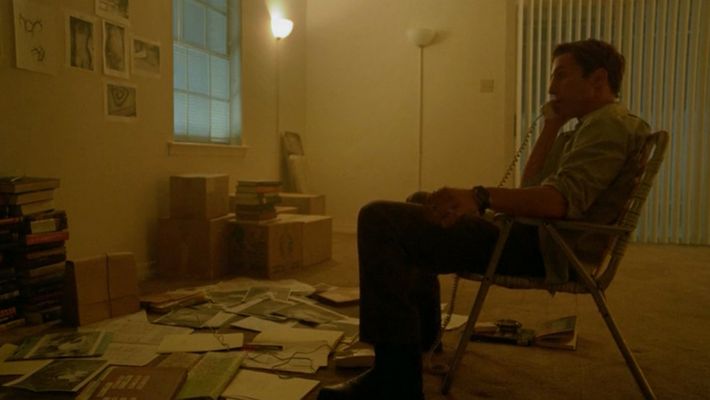
Episode three, “The Locked Room” — Maggie Calls Rust
Arkapaw insists his choice to consistently drown Rust in a grimy gold light had nothing to do with the looming presence of the Yellow King. It was just gross. “His apartment was supposed to be a place that you don’t want to spend too much time in,” Arkapaw jokes. “[But] from a design point of view, they did have a lot of fun with the color yellow.” For Fukunaga and the DP, it was all about making scenes pop with striking images and dramatic coherency. Rust’s living conditions — bare-bones decorations and white walls — were drab, but familiar. Arkapaw made the set pop by throwing a filter on his camera — an “Antique Suede,” to be precise. Instead of colorizing in postproduction, the cinematographer slipped a piece of brown glass in front of his lens. When Maggie jumps on the phone, Fukunaga and Arkapaw positioned each character to trick audiences’ brains with a sense of intimacy. By framing McConaughey and Michelle Monaghan on the right side of each shot, they appear to be conversing as if they were in the same room.
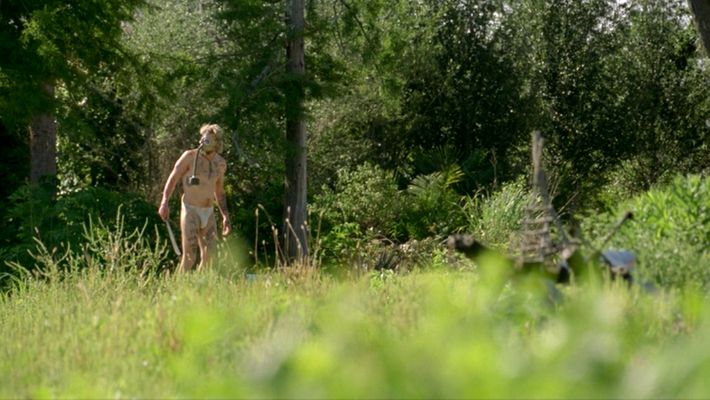
Episode three, “The Locked Room” — Reggie Emerges From the Woods
“Slow-motion can really emphasize a point you want to dwell on,” Arkapaw says of the show’s iconic masked-man-in-a-jock-strap image. By rarely stylizing the photography, the moments where True Detective does drift into the cinematic creates an instant stamp on the viewer’s mind. Many of these choices were made by Fukunaga and Arkapaw on set, in the thick of shooting. “Once we’re on location, it’s more about the story,” he says. “The angle for that particular shot becomes the point of view that Marty and Rust take when they first arrive at the compound. A long lens and a little voyeuristic.”
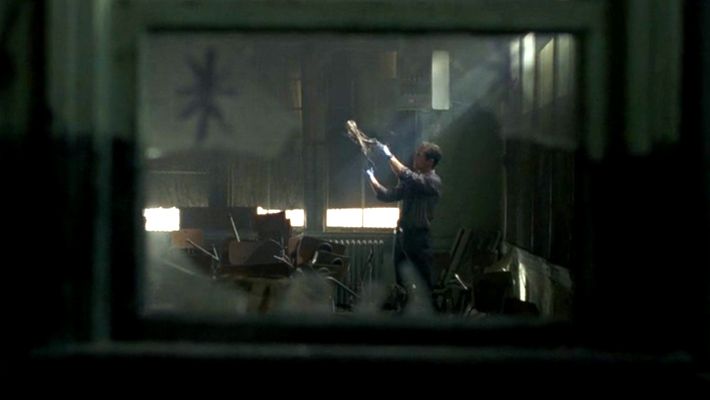
Episode five, “The Secret Fate of All Life” — Rust Discovers Totems in the Light of Way School
While portions of Pizzolatto’s script had to be rewired to fit True Detective’s Louisiana setting (backwood forests became thick stretches of bayou grass), the state sported a number of locations appropriate for the show’s Southern Gothic tone. The abandoned school where Rust makes one of his biggest finds was actually an abandoned school. “It was all boarded up when we found it,” Arkapaw laughs. “So we had the idea to pull the boards down and pump a little light in there to heighten the suspense and make it a bit dreamy.” The cinematographer asked questions with his photography: Is Detective Cohle tripping out, or can we trust his perspective? Shafts of light, the musk of the room, dust glimmer in the air — moody teetering on the edge of too moody. Arkapaw recalls movies like Biutiful and Se7en that balance this line and provide inspiration for scenes like this. “Little moments of weirdness and how seamless they were.”
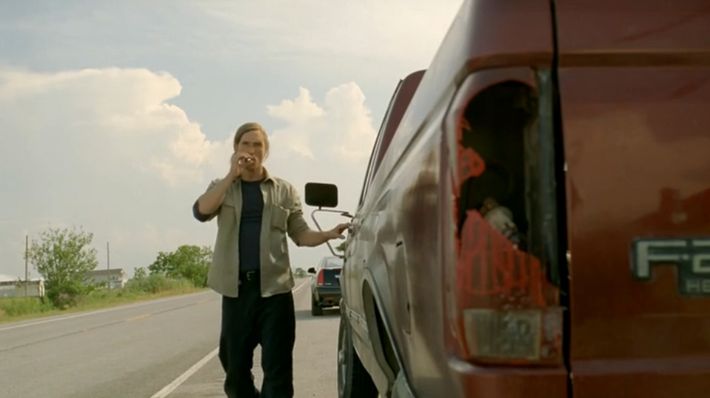
Episode six, “Haunted Houses” — Present-Day Rust and Marty Reunite
The impulse for Fukunaga and Arkapaw was to go long and wide as often as possible, pulling back and finding angles that TV rarely uses. But when wrapping up the season’s sixth episode, the duo couldn’t help but stray from the plan of action for a powerful, close-up composition. “That’s an idea we had on the day,” Arkapaw recalls. “It was scripted that the tail-light was still broken. It was a poetic time to remember the time they fell out.”
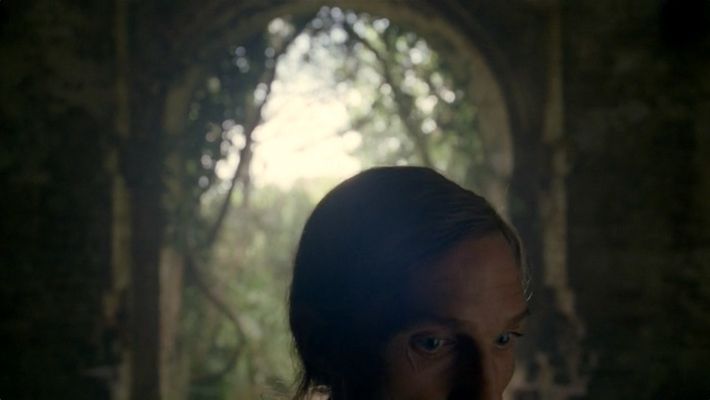
Episode eight, “Form and Void” — Entering Carcosa
Standing in for Errol’s Lovecraftian labyrinth were the stone hallways of Fort Macomb, built in 1822. The overgrown entranceway of the crumbling structure provided Fukunaga and Arkapaw with their central metaphor: Rust stepping from brightness to consuming darkness. The cinematographer says his conversations with Fukunaga rarely touched upon noir influences (although they share a love for The Third Man), instead harkening back to classic Renaissance painting. “We embraced the contrast,” Arkapaw says. “Cary was definitely interested in chiaroscuro [a technical term for the juxtaposition of light and dark]. I don’t particularly like it when you can see the actual idea of the photography clearly. But I’m sure those influences bled in there.”
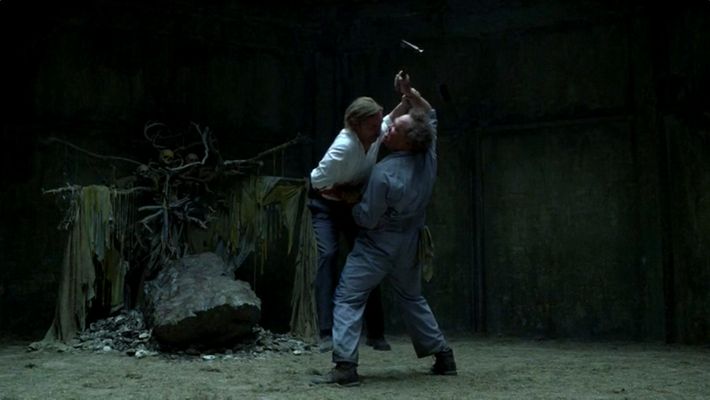
Episode eight, “Form and Void” — Errol Rushes and Stabs Rust
Whereas Fort Macomb provided a twist-y, turn-y descent into hell, the final ring, where good encounters evil, was a smoothly integrated bit of set work. “You’re going into the mind of the killer. It’s the center of the brain. So it’s a poetic idea, and you have poetic license to do something heightened,” says Arkapaw.
The production team built 18-foot-tall walls to surround the actors, but above them was the dangling rig providing a single beam of light. The magic of CG transformed it into a rooftop and later inserted the glow of the moon. Arkapaw needed flexibility in the lighting; by the time they shot the Errol-Rust showdown, Pizzolatto and Fukunaga weren’t certain what Rust would see when he entered Carcosa’s center chamber. “We had to get Childress in the room to stab him somehow,” says the DP. “Rust is set up as a dangerous character and well-trained, so we had a few different theories on what would distract him.” Arkapaw keeps mum on alternatives to the blue-hued portal that mesmerizes Rust. True Detective needs its secrets.

